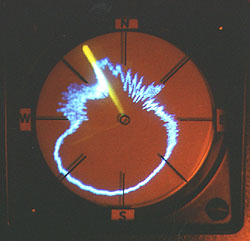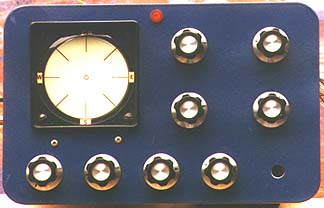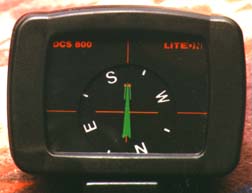

Homing In for August 1997 described an analog multiplier circuit that combines fluxgate compass and receiver S-meter signals to produce a "north-up" display of signal strength versus direction (see photo above). I call it the NorthScope. Its polar plot simplifies the task of separating the direct signal from multiple reflections (multipath) in urban and hilly areas. The September 1997 installment describes the conversion of an inexpensive classic Heathkit SB-620 "Scanalyzer" into a low-drain high-persistence CRT display for the NorthScope.
Here are PDFs of these columns:
August 1997 -- Build the NorthScope
September 1997 -- Low Cost Monitor for the NorthScope
Here is some additional information to supplement the magazine's description of this project. It is of particular interest to experimenters who wish to build their own compasses and/or monitors instead of following the plans in the above-mentioned articles.

This remodeled Scanalyzer isn't "Heath green" any more. It has been turned into a long-persistence monitor for the north-up RDF display. An added DC-to-AC converter inside powers it, drawing only 600 milliamperes from the vehicle battery. The CRT face grid has been replaced by a compass rose. Next comes the addition of a final control and panel lettering. Details are in Homing In for September 1997.
To insure that there is sufficient "headroom" to accommodate the possible ranges of input voltages and supply voltages, I simulated the analog multiplier circuits (August issue) using two circuit analysis programs. Below is a graph of the output of the SPICE3 analysis. It shows how a linear increase in S-meter voltage causes the sin/cos signal to increase linearly, making the scope trace grow in proportion to signal level.

Traces are as follows:
Red - Sine or cosine input from the fluxgate compass, superimposed on the +4.2 volt analog reference. (10 rotations)
Green - S-meter input after addition of +4.2 volt reference at U3-D output. Full-scale is 4.2 + 1.8 = 6.0 volts.
Blue - Multiplier output to the CRT display. The 4.2 volt reference is offset by the POSITION control in the display as necessary to center the spot.
Click here to display the modified SB-620 HVPS schematic in JPEG format. It shows the HV transformer, rectifier/filters, and connections to the cathode, grid, and anode of the CRT. Also included are the intensity, focus, and astigmatism control wiring. This is useful if you don't have a SB-620 manual or you decide to build your CRT display from scratch. The inverter in the September article drives the 110VAC transformer input on this schematic. Output voltage values on this schematic are for 110 VAC sinewave input. Using the squarewave DC-to-AC converter, RMS heater voltage is about the same, but DC cathode and anode voltages are about 35% less. This is not a problem in mobile operation, except in bright sunlight.
As you look at July 1997 Homing In, you may notice a strange similarity between Photos A and C. Somehow 73's layout computer put a squished version of Photo C in place of Photo A. The correct Photo A (front view of the LiteOn DCS800 fluxgate compass) is shown below.

LiteOn DCS800 Fluxgate Compass
Click here for a "north-up" overlay for the CRT face. Use transparency film (CG3300 by 3M Company) in place of paper in your laser printer to get a transparent copy.
Finding older model Heathkits isn't difficult if there are ham radio flea markets and swap meets in your area. Also check the classifieds in QST magazine and Amateur Radio Trader magazine.
Don't know much about Heathkits? Check out the Web sites devoted to this very important company in the history of ham radio. Here's one to get you started, the Heathkit Virtual Museum.
There is a Heathkit swap/info net Sundays on 14,293 KHz at 1530 Eastern Time. Net Control is WB6LRG in central California.
Keep in mind that some Heathkit collectors may not take kindly toward the idea of "recycling" a pristine SB-620 into a device for mobile T-hunting. They might even use the word "butchering." Be compassionate.
Heath Company isn't making kits any more, but is selling photocopies of most Heathkit manuals. Phone (616) 925-5899 between 8 AM and 4 PM Eastern Time for more information or send e-mail to techsupport@heathkit.com.
Another source of manuals for Heathkits and other vintage electronic equipment is W7FG, phone (800) 807-6146.
Black, "Build This Digi-Compass" Radio-Electronics, November 1989, pp. 43-51, 82
Carr, "Analog Multiplier IC's," Electronics Now, July 1993, pp. 65-68, 90
Noble, "Electronic Fluxgate Compass," Electronics and Wireless World, January 1992, pp. 14-18
Ramsden, "Measuring Magnetic Fields with Fluxgate Sensors," Sensors Magazine, September 1994, pp. 87-90
The article by Black includes info on how to display sine/cosine data on a personal computer.
As one who learned electronics in the 1950s and 1960s, I am very fond of cathode-ray tubes (CRTs) and old-school analog circuits. Nevertheless, I realize that this is the 21st century and many readers would prefer an all-digital polar bearing display. If so, consider the work of Bob Simmons WB6EYV, the designer of PicoPlot hardware and WinPlot software. Bob's complete project description is in the January-February 2014 edition of QEX Magazine from ARRL. PicoPlot does not include an electronic compass, so its displayed bearings are relative to the vehicle heading. Who will be the first to add a compass to make it a north-up display?
© 1997, 2014 Joseph D. Moell. All rights reserved.
This page updated 13 November 2023
All-digital Alternative

 Back to the Homing In home page
Back to the Homing In home page